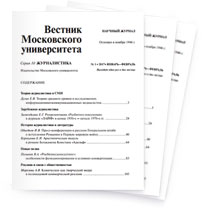Communication with the Involvement of Hearing and Deaf/Hard of Hearing People: Social Media Opportunities
Download paperGraduate PhD student of the Chair of New Media and Communication Theory, Faculty of Journalism, Lomonosov Moscow State University, Moscow, Russia
e-mail: ju.shamsutdinova@gmail.comSection: New Media
The paper presents the findings of the research which was aimed at getting an idea of communication of hearing and deaf/hard of hearing people in real life and in social media. The empirical basis of the study is composed of focused interviews with non-ordinary representatives of the group studied, who are simultaneously the holders of expert knowledge about the life of the deaf and hard of hearing community. It was found that the main conditions influencing the process of the deaf and hard of hearing people’s communication, are the choice of language, the extent of hearing loss and the age when hearing was lost. The research also resulted in the construction of two theoretical models of communication, whose participants are hearing and deaf or hard of hearing people. The models are applicable both to communication that proceeds in real life and to communication in social media. Both models take into account the presence of the main communication barriers. One of the respondents’ statement, according to which deaf and hearing people practically do not communicate in social media, requires further study.
DOI: 10.30547/vestnik.journ.5.2020.5476References:
Berko R. M., et al. (2010) Communicating. 11th ed. Boston: Pearson Education. Pp. 9–12.
Bol’shakov N. V. (2017) Vozmozhnosti primeneniya strategii smeshivaniya metodov pri izuchenii soobshchestva glukhikh i slaboslyshashchikh [The Possibilities of Using the Strategy for Mixing Methods in Studying the Community of the Deaf and Hard of Hearing]. Vestn. Tomsk. gos. un-ta. Filosofiya. Sotsiologiya. Politologiya 38: 154–165. (In Russian)
Boskis P. M. (2004) Glukhie i slaboslyshashchie deti [Deaf and Hard of Hearing Children]. Moscow: Sovetskiy sport; illustrations: (Zolotye stranitsy surdopedagogiki). (In Russian)
Bukhtiyarova I. N. (2015) Informatsionnye tekhnologii kak faktor razvitiya sovremennogo inklyuzivnogo obshchestva [Information Technologies as a Development Factor of a Modern Inclusive Society]. Gumanitarnye, sotsial’no-ekonomicheskie i obshchestvennye nauki 6-1: 122–125. (In Russian)
Burgoon J. K., Hale J. L. (1988) Nonverbal Expectancy Violations: Model Elaboration and Application to Immediacy Behaviors. Communication Monographs 55 (1): 58–79. DOI: https://doi.org/10.1080/03637758809376158
Chang C. M. (2014) New Media, New Technologies and New Communication Opportunities for Deaf/Hard of Hearing People. In International Conference on Communication, Media, Technology and Design. Pp. 24–26.
Katz E., Lazarsfeld P. F. (1955) Personal Influence. New York: Free Press.
Marschark M., Spencer P. E. (2010) The Oxford Handbook of Deaf Studies, Language, and Education, Vol. 2. New York: Oxford University Press. DOI: 10.1093/oxfordhb/9780195390032.001.0001
Silverman D. (1993) Interpreting Qualitative Data. London: Sage Publications.
Stokoe W. C. (1960) Sign Language Structure: An Outline of the Visual Communication Systems of the American Deaf. Studies in Linguistics, Occasional Papers, Vol. 8. Buffalo: University of Buffalo.
Vartanova E. L. (ed.) (2019) Otechestvennaya teoriya media: osnovnye ponyatiya. Slovar’ [Russian Media Theory: Major Concepts. Vocabulary]. Moscow: MSU Faculty of Journalism; Moscow St. Univ. Publ. (In Russian)
Vatslavik P., Bivin D., Dzhekson D. (2000) Pragmatika chelovecheskikh kommunikatsiy: izuchenie patternov, patologiy i paradoksov vzaimodeystviya [Pragmatics of Human Communications: a Study of Patterns, Pathologies and Paradoxes of Interaction]. Moscow: Aprel’Press Publ.; «ESMO-Press» Publ. (In Russian)
Vygotskiy L. (1995) Problemy defektologii [Defectology Problems]. Moscow: Prosveshchenie Publ. (In Russian)
Yakobson R. (1985) Izbrannye raboty [Selected Works]. Moscow. Pp. 319– 321. (In Russian)
Yarskaya-Smirnova E. R. (2001) Muzhchiny i zhenshchiny v strane glukhikh [Men and Women in the Country of the Deaf]. In Odezhda dlya Adama i Evy: Ocherki gendernykh issledovaniy [Clothes for Adam and Eve. Essays in Gender Studies]. Moscow. Pp. 221–236. (In Russian)
Zaytseva G. L. (2000) Zhestovaya rech’. Daktilologiya. Ucheb. dlya stud. vyssh. ucheb. zavedeniy [Gesture Speech. Dactylology. A Textbook for University Students]. Moscow: VLADOS Publ. (In Russian)
Zaytseva G. L. (2006) Zhest i slovo: nauchnye i metodicheskie stat’i [A Gesture and a Word: Scholarly and Methodological Articles]. Moscow. (In Russian)
Zubkova I. V. (2011) Kommunikativnye bar’ery kak faktor povysheniya riska neponimaniya v mezhlichnostnykh otnosheniyakh [Communication Barriers as a Factor of Increased Risk of Misunderstanding in Interpersonal Relations]. Izvestiya Saratovsk. un-ta. Novaya seriya. Seriya Akmeologiya obrazovaniya. Psikhologiya razvitiya 4 (2): 72–76. (In Russian)






